 |
 10-17-2022, 08:47 AM
10-17-2022, 08:47 AM
|
#1
|
|
Winnebago Camper
Join Date: Oct 2022
Posts: 7
|
View 12V Battery Disconnect switch not disconnecting
My 2013 View Profile's battery disconnect switch is not disconnecting the 12v to the coach when pressed. I believe the solenoid is under the passenger seat. Any helpful hints as how to procede?
|

|

|
 10-17-2022, 11:41 AM
10-17-2022, 11:41 AM
|
#2
|
|
Winnebago Master
Join Date: Nov 2018
Location: Pflugerville/Austin, Tx
Posts: 7,521
|
Several points that may help, even though we get less wiring info on the newer RV.
One biggie often missed is that the switch operates a relay and that relay has to have 12VDC power to make it move!
So make sure the battery supply is good if trying to turn the power back on! Disconnecting, this may not be your problem but something to keep in mind for later?
Then there is some info to help sort what we have here as it shows the switch and what circuits and wire ID are used at that switch.
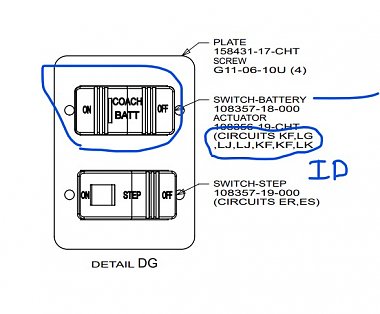
With that info, we can go to a list of wire ID here:
https://www.winnebago.com/Files/File...ical_guide.pdf
By hitting "ctrl and F" at the same time, we get a space to put in the ID we want to search and it brings a list of them as a way to avoid scrolling all the way through the large list.
Also when tracing the wires, there should be labelsstamped on the wires as this example:
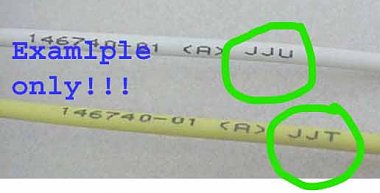
The circuits and breakers are here:
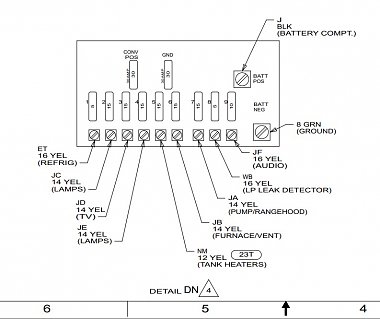
You are correct for the location as it is the yellow item on this drawing:
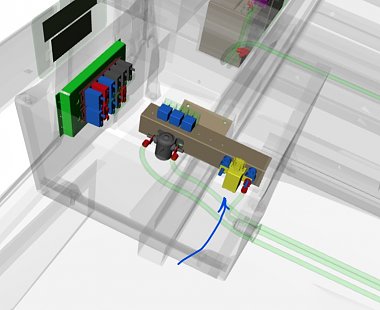
I might suggest going this way?
1. I would want to verify the switch and wiring from it to the relay is good. This can be done by listening/feeling the relay while someboy pushs the disconnect switch. It is not a big heavy relay so it may not be heard well from the switch?? If the relay moves, you can move from the switch and not take it out of the wall!
2. Assuming the relay moves when the switch is pushed, then you need to check the wires feeding battery and ground to the circuits as the wire ID chart gives.
Big point? Make sure the 12VDC is getting to the relay for it to switch and pass on to the RV. If that cable is loose or corroded before power gets to the relay, it can't pass it on.
Check for mega fuses, corrosion between that point and battery?
We don't get the real wire by wire schematics for post 2010 models so we have to hunt and peck using this limited info. Sorry! That's about all we get! 
__________________
Richard
Why no RV year, make and floorplan on MY signature as we suggest for others?
I currently DO NOT have one! 
|

|

|
 10-17-2022, 02:39 PM
10-17-2022, 02:39 PM
|
#3
|
|
Winnebago Camper
Join Date: Oct 2022
Posts: 7
|
reply to Richard
Richard, Thanks for all the information however the issue is not the switch turning the power on, it's turning the power off. So when I hit the switch the solenoid does nothing. Can I assume the solenoid is bad?
|

|

|
 10-17-2022, 03:05 PM
10-17-2022, 03:05 PM
|
#4
|
|
Winnebago Master
Join Date: Apr 2018
Location: Tucson, AZ
Posts: 1,215
|
By any chance you are not plugged into shore power are you?
__________________
Brian
2011 Winnebago Via 25Q on 2010 Sprinter Chassis
|

|

|
 10-17-2022, 03:54 PM
10-17-2022, 03:54 PM
|
#5
|
|
Winnebago Master
Join Date: Nov 2018
Location: Pflugerville/Austin, Tx
Posts: 7,521
|
Quote:
Originally Posted by Herberger

Richard, Thanks for all the information however the issue is not the switch turning the power on, it's turning the power off. So when I hit the switch the solenoid does nothing. Can I assume the solenoid is bad?
|
Let me make sure we are speaking the same as solenoid and relay can often be used for the same thing!
I use solenoid for the mode solenoid which is not involved in this one, while relay is the one on the right and is the one you need to move.
But that is where you need to look carefully as it is a "latching relay" and that means it has a magnetic gizmo which keeps it "latched" in the last positon, even when we turn the switch loose.
So the metal solenoid is not involved.The relay is more the plastic looking one on the right and it may be bad but it may also be simply "latched" until it gets a signal to move and that can be a switch or wiring problem.
Since it is not moving, no way to hear it!! Sorry about missing that. And that gets more difficult as you will need to get out a meter and do some testing on the wiring.
It may be time to get the switch out of the wall to test on the back of it or is it easier to get under the seat?
What the ID chart shows is that there should be a wire labeled LJ from battery to the switch. Also possibly a wire LK to light a light on the switch but that may be an option and doesn't change the relay operation but there to indicate switch position. If you can get to the back of the switch and locate that power coming to the switch, it is likely a center lug between terminals I and S. Those terminals have wires LG and LH on them.
The idea is that when there is power on the center lug and we push the switch one way, that power should connect to LG and make the relay engage. But what is failing is the other way that should connect power to LH to disengage!
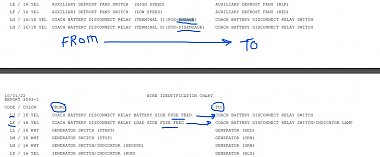
What I think you will find is like this simple drawing I made? That switch is a momentary switch and stay in the center when normal.
Then when we push it one way it connects LJ to LG and sends power to the relay to engage or close the relay .
The part which is not working is getting the switch to connect power on LJ through contacts to LH to send the signal to the relay to disengage!
So the trick is finding If 12 volts is getting to LJ?
Is the switch then sending it on to LH?
IF it is why is the relay not moving? Maybe corroded connection at the relay or maybe a bad relay.
But before I changed the relay, If I could sort out where that wire LH connects to the relay, I would use a small jumper wire to put 12v on that point on the relay.
Maybe if the relay is easier to get to, I might skin a small point on wire LH at the relay and touch 12v to it to see if it jumps and turns the lights on! Maybe run a pin through the insulation and touch 12 volts to the pin?
Sometimes it is easier to skin and repair a small nick in the wire than to dig the switch out of the wall?
__________________
Richard
Why no RV year, make and floorplan on MY signature as we suggest for others?
I currently DO NOT have one! 
|

|

|
 10-17-2022, 06:19 PM
10-17-2022, 06:19 PM
|
#6
|
|
Winnebago Camper
Join Date: Oct 2022
Posts: 7
|
Quote:
Originally Posted by bigb

By any chance you are not plugged into shore power are you?
|
No I am not plugged into shore power
|

|

|
 10-17-2022, 06:27 PM
10-17-2022, 06:27 PM
|
#7
|
|
Winnebago Camper
Join Date: Oct 2022
Posts: 7
|
Quote:
Originally Posted by Morich

Let me make sure we are speaking the same as solenoid and relay can often be used for the same thing!
I use solenoid for the mode solenoid which is not involved in this one, while relay is the one on the right and is the one you need to move.
But that is where you need to look carefully as it is a "latching relay" and that means it has a magnetic gizmo which keeps it "latched" in the last positon, even when we turn the switch loose.
So the metal solenoid is not involved.The relay is more the plastic looking one on the right and it may be bad but it may also be simply "latched" until it gets a signal to move and that can be a switch or wiring problem.
Since it is not moving, no way to hear it!! Sorry about missing that. And that gets more difficult as you will need to get out a meter and do some testing on the wiring.
It may be time to get the switch out of the wall to test on the back of it or is it easier to get under the seat?
What the ID chart shows is that there should be a wire labeled LJ from battery to the switch. Also possibly a wire LK to light a light on the switch but that may be an option and doesn't change the relay operation but there to indicate switch position. If you can get to the back of the switch and locate that power coming to the switch, it is likely a center lug between terminals I and S. Those terminals have wires LG and LH on them.
The idea is that when there is power on the center lug and we push the switch one way, that power should connect to LG and make the relay engage. But what is failing is the other way that should connect power to LH to disengage!
Attachment 184461
What I think you will find is like this simple drawing I made? That switch is a momentary switch and stay in the center when normal.
Then when we push it one way it connects LJ to LG and sends power to the relay to engage or close the relay .
The part which is not working is getting the switch to connect power on LJ through contacts to LH to send the signal to the relay to disengage!
So the trick is finding If 12 volts is getting to LJ?
Is the switch then sending it on to LH?
IF it is why is the relay not moving? Maybe corroded connection at the relay or maybe a bad relay.
But before I changed the relay, If I could sort out where that wire LH connects to the relay, I would use a small jumper wire to put 12v on that point on the relay.
Maybe if the relay is easier to get to, I might skin a small point on wire LH at the relay and touch 12v to it to see if it jumps and turns the lights on! Maybe run a pin through the insulation and touch 12 volts to the pin?
Sometimes it is easier to skin and repair a small nick in the wire than to dig the switch out of the wall? |
WOW that is involved. Looks like it's back the dealer for me. This is getting a little out of my comfort zone. Thank you all for the feedback, much appreciated
|

|

|
 10-17-2022, 07:33 PM
10-17-2022, 07:33 PM
|
#8
|
|
Winnebago Master
Join Date: Nov 2018
Location: Pflugerville/Austin, Tx
Posts: 7,521
|
Okay, fully understand not wanting to go way out of the comfort zone. It really is important to know when to say enough is enough!
I kind of grew up with it on my mind. Some of my first electronic work was trying to repair the lights on farm wagons and that was because I was too short and weak to throw a bale from the wagon to the loft, so they thought I might as well be good for something.
Being small I did fit under the wagon and tractor better than some!
__________________
Richard
Why no RV year, make and floorplan on MY signature as we suggest for others?
I currently DO NOT have one! 
|

|

|
 10-18-2022, 07:56 AM
10-18-2022, 07:56 AM
|
#9
|
|
Winnebago Master
Join Date: Nov 2018
Location: Pflugerville/Austin, Tx
Posts: 7,521
|
BUT---Before giving too easy, I might point to one other easy shot to try?
One of the problems with the newer RV is that we are limited on the info we get for wiring schematics, making it harder to chase circuits.
A big question was where does LJ get that 12 volts to use for throwing the relay?
I finally woke up to maybe looking on a different set of breakers which is outside , likely just behind the driver and near the mode solenoid and disconnect relay!
It may be the breaker has tripped as it is only 6 amp which tends to be easier to trip than larger.
May be check this carefully before going for repair?
__________________
Richard
Why no RV year, make and floorplan on MY signature as we suggest for others?
I currently DO NOT have one! 
|

|

|
 10-18-2022, 08:14 AM
10-18-2022, 08:14 AM
|
#10
|
|
Winnebago Camper
Join Date: Oct 2022
Posts: 7
|
Thanks, I'll check that out. My breakers are under the passenger seat but I'll look to see if there are others by the drivers. Thanks for all your input.
|

|

|
 10-18-2022, 09:15 AM
10-18-2022, 09:15 AM
|
#11
|
|
Winnebago Master
Join Date: Nov 2018
Location: Pflugerville/Austin, Tx
Posts: 7,521
|
OK! Should be behind a cover like this but it is big and easy to spot when you do see it!
I missed it on first look at the breakers that I spotted first! Different group, different location??
As mentioned, we are a little handicapped on the newer RV.
EDIT:
You are correct on the location. The first group I found are back on the load center and not involved on this question!
__________________
Richard
Why no RV year, make and floorplan on MY signature as we suggest for others?
I currently DO NOT have one! 
|

|

|
 10-18-2022, 01:12 PM
10-18-2022, 01:12 PM
|
#12
|
|
Winnebago Master
Join Date: Nov 2018
Location: Pflugerville/Austin, Tx
Posts: 7,521
|
While this seems a really complex/difficult area, it can be easier to understand if we look at it in smaller portions.
So while the OP is checking the breaker before taking it in to the shop, maybe we can do some looking as this is what many of the RV have when we use the Coach battery disconnect and it may help to get the basics in mind and that makes it easier to understand, even if getting the switch or relay out where we can reach them is still a problem!
I made this small drawing so we can talk it over.
One basic idea in electricity is that it has to have a full circuit (circle?) to make anything operate.
Second is that a relay is just a switch that has contacts that close or open but instead of us moving the switch, we use elctricity through a coil to move the contacts.
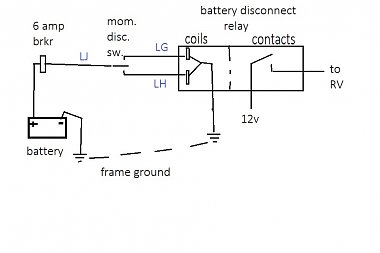
On this drawing, I've shown the battery with the negative side running down to the frame which we use as ground in RV. The positive side of the battery is connected to the 6 amp breaker that OP is checking and if that breaker is good, the power goes out on wire LJ to the battery disconnect switch.
That switch is normally open as it is a momentary switch that only closes in one of the two positions, either to close (engage?) the relay contacts or open (disengage?) the relay contacts.
When we push the switch one way it puts power on wire LG and that power passes on to the coil of the relay to make it move to close the contacts. Or we push it the other way and make the power go to the relay on LH and it jumps the other way!
Opening or closing those cantacts is just like us flipping a switch, it makes the battery connect or disconnect!
The tricky part is that this relay is built so that it has a magnet which "latches" the relay in the last position! That's good because we only use up our battery power while we have the switch pushed, not the entire time we are camped or stored!
So if we have all the things on the left working right to make a full circle , that should make the contacts on the right close and turn the battery on or off.
You really can boil all that "lectrick stuff" down to one sentence! 
__________________
Richard
Why no RV year, make and floorplan on MY signature as we suggest for others?
I currently DO NOT have one! 
|

|

|
 10-18-2022, 02:29 PM
10-18-2022, 02:29 PM
|
#13
|
|
Winnebago Camper
Join Date: Oct 2022
Posts: 7
|
Thanks, Yes they ar on the passenger side & no it didn't change the situation.
I appreciate the thought though.
|

|

|
 10-18-2022, 04:17 PM
10-18-2022, 04:17 PM
|
#14
|
|
Winnebago Master
Join Date: Nov 2018
Location: Pflugerville/Austin, Tx
Posts: 7,521
|
Some days are like that, we do all we canvand then do somethingvelse.
__________________
Richard
Why no RV year, make and floorplan on MY signature as we suggest for others?
I currently DO NOT have one! 
|

|

|
 |
|
Currently Active Users Viewing This Thread: 1 (0 members and 1 guests)
|
|
|
 Posting Rules
Posting Rules
|
You may not post new threads
You may not post replies
You may not post attachments
You may not edit your posts
HTML code is Off
|
|
|
|
 » Recent Discussions
» Recent Discussions |
|
|
|
|
|
|
|
|
|
|
|
|
|
|
|
|
|
|
|
|
|
|
|
|
|